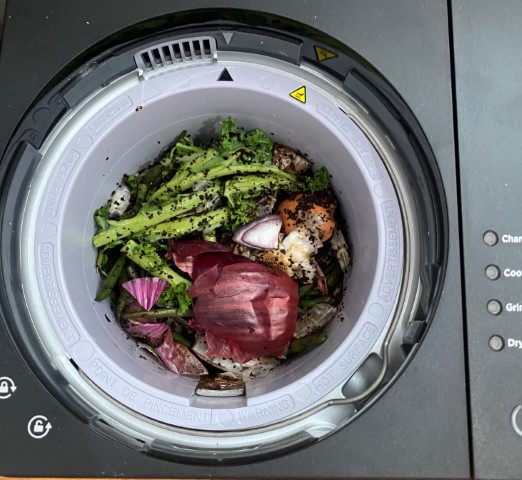


A “Foodcycler” is a product that calls itself an “electric composter.” It dehydrates and pulverizes food quickly, leaving behind dehydrated food waste (DFW). To use this DFW, Foodcycler recommends a 1-month cure, additional microbial treatment, and a soil application ratio of 3/10. I’ll dive into these guidelines, and will investigate whether they can be tweaked to make it an attractive option for home use.
Large-scale or non-consumer versions have been around some time, and range from shipping container-sized bespoke installations down to cooler-sized processors. For consumers, the current landscape seems dominated by Foodcycler, which is sold under the Foodcycler, Breville, or Vitamix names.
Startups prpjects that aim to improve upon the DFW-producing design (by kicking out finished compost instead) include the Kalea project, the Zera food recycler, and the Lomi device (among others).
This analysis explores how effective this product can be at the individual level and inherently discounts benefits at scale. I posit that individual adoption at any level is a good angle of attack to couple with - or create demand for - incentivized approaches (grants etc). The latter is something that has been done and in some cases where it hasn’t there can be found a potential regulatory framework.
There are numerous studies related to the potential of scaling this technology including a municipal deployment of this specific product and the carbon economics vs traditional recycling (below) that I’ll dive into in a follow-on note.
The purpose of this analysis is to determine whether the Foodcycler can serve as a tool to process our food waste back into an input that meaningfully replaces one or multiple inputs that we regularly purchase.
Vitamix sells “foodilizer” tablets to be dissolved and sprayed on the finished product to aid in soil decomposition. They mention Trichoderma, Bacillus, and some other ingredients similar to those who have encountered Mycorrhizal Fungi and helper bacteria. There is unfortunately, nothing further available as to which strains are included…something we’ll likely want control over.
| item | $ total | oz weight | $ / oz |
|---|---|---|---|
| Foodilizer | 20 | 0.3 | 67 |
| Great White | 20 | 4 | 5 |
They’re not cheap at roughly 0.3oz for $20 vs ~$5/oz for proven suppliers with targeted offerings. Because of this we’re unlikely to use them long-term and will pass on testing the tablets in lieu of another supplier
| item | type | $ | $ total |
|---|---|---|---|
| unit | initial | 299 | 299 |
| filter | tri | 25 | 75 |
| electric | annual | 20 | 20 |
| microbial | annual | * | * |
The Device cost ~$300, which I won’t count because I posit that widespread, scaled adoption would come with subsidies (as explored here). I’ll cover that in depth in a later note, but keep in mind that a municipal garbage/recycling bins alone can cost roughly the same as a unit - and are often filled with food waste.
Electricity is ~$0.06/day at Chicago’s average kWh price of ~$0.13 (~$21/yr)
I do not know the qty of microbial amendments we’ll need yet, but I am positive we’ll need them. Our combined spend for that and non-seed/water inputs:
| category | item | type | $ | $ total |
|---|---|---|---|---|
| nute | big bloom 32oz | quarterly | 20 | 80 |
| amend | great white | triannually | 20 | 60 |
| soil | purple cow/FFOF | quarterly | 30 | 120 |
We spend ~$260/year on nutrients, microbial amendments, and soil. We need only to eliminate the “big bloom” nutrient entirely and slightly reduce soil use by adding in DFW at the suggested 3/10 ratio to break even. Selectivity RE food recycled will be our friend in dialing in a nutrient replacement for specific crops. Big Bloom is potassium heavy, but that’s not really necessary for general vegetable growth.
If we could move from the suggested 3/10 amendment ratio toward 1/2 or higher, then we could likely replace meaningful soil input $ as well - I will test increasingly large amounts until we hit the death/damage range to see what the “average cap” can be.
As the season rolls in I will also look to add this “pre-digested” food to our compost tumbler to see whether it can accelerate the composting process.
A fallback option could be compost teas…something we will be doing more of when we switch our indoor grow to no-till. This entails putting the DFW into cheesecloth and boiling it like a tea bag, then using the solution as a liquid fertilizer.
~5hours, very little noise compared to a modern dishwasher.
We did not read the instructions carefully RE “stringy” vegetables - still seemed to process fine. Experiments with the resulting DFW is can be found here